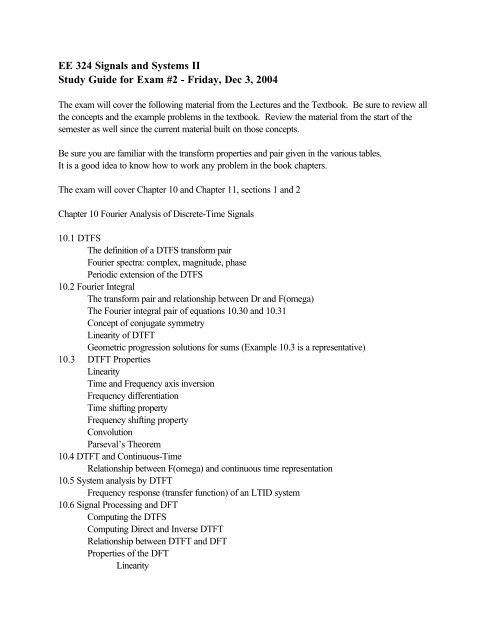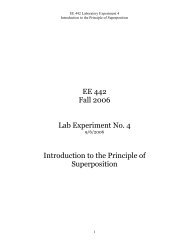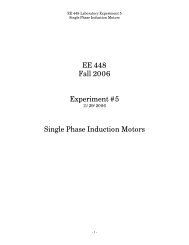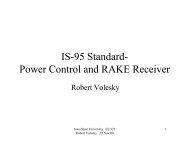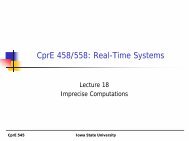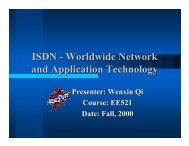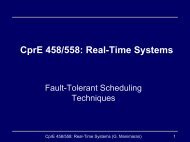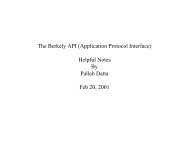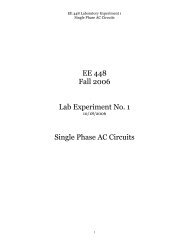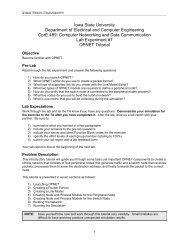EE 324 Signals and Systems II Study Guide for Exam #2 - Friday ...
EE 324 Signals and Systems II Study Guide for Exam #2 - Friday ...
EE 324 Signals and Systems II Study Guide for Exam #2 - Friday ...
- No tags were found...
You also want an ePaper? Increase the reach of your titles
YUMPU automatically turns print PDFs into web optimized ePapers that Google loves.
<strong>EE</strong> <strong>324</strong> <strong>Signals</strong> <strong>and</strong> <strong>Systems</strong> <strong>II</strong><strong>Study</strong> <strong>Guide</strong> <strong>for</strong> <strong>Exam</strong> <strong>#2</strong> - <strong>Friday</strong>, Dec 3, 2004The exam will cover the following material from the Lectures <strong>and</strong> the Textbook. Be sure to review allthe concepts <strong>and</strong> the example problems in the textbook. Review the material from the start of thesemester as well since the current material built on those concepts.Be sure you are familiar with the trans<strong>for</strong>m properties <strong>and</strong> pair given in the various tables.It is a good idea to know how to work any problem in the book chapters.The exam will cover Chapter 10 <strong>and</strong> Chapter 11, sections 1 <strong>and</strong> 2Chapter 10 Fourier Analysis of Discrete-Time <strong>Signals</strong>10.1 DTFSThe definition of a DTFS trans<strong>for</strong>m pairFourier spectra: complex, magnitude, phasePeriodic extension of the DTFS10.2 Fourier IntegralThe trans<strong>for</strong>m pair <strong>and</strong> relationship between Dr <strong>and</strong> F(omega)The Fourier integral pair of equations 10.30 <strong>and</strong> 10.31Concept of conjugate symmetryLinearity of DTFTGeometric progression solutions <strong>for</strong> sums (<strong>Exam</strong>ple 10.3 is a representative)10.3 DTFT PropertiesLinearityTime <strong>and</strong> Frequency axis inversionFrequency differentiationTime shifting propertyFrequency shifting propertyConvolutionParseval’s Theorem10.4 DTFT <strong>and</strong> Continuous-TimeRelationship between F(omega) <strong>and</strong> continuous time representation10.5 System analysis by DTFTFrequency response (transfer function) of an LTID system10.6 Signal Processing <strong>and</strong> DFTComputing the DTFSComputing Direct <strong>and</strong> Inverse DTFTRelationship between DTFT <strong>and</strong> DFTProperties of the DFTLinearity
Conjugate symmetryTime shiftingFrequency shiftingCircular convolutionUse <strong>and</strong> effects of Zero PaddingFiltering in the frequency domainChapter 11 Z-Trans<strong>for</strong>m11.1 Z-Trans<strong>for</strong>mRelation of DTFT to Z-Trans<strong>for</strong>mDefinition of the trans<strong>for</strong>m pairProperties of the Z-trans<strong>for</strong>mLinearityRegion of Convergence (ROC)Inverse Trans<strong>for</strong>m11.2 Properties of Z-Trans<strong>for</strong>mDelayAdvanceConvolutionMultiplication by gamma to the k powerMultiplication by kSome things you need to know in general;Conjugate SymmetryConvolutionComplex numbers <strong>and</strong> Complex algebraPartial fraction expansion (Heaviside <strong>and</strong> modified Heaviside)Closed <strong>for</strong>m solutions <strong>for</strong> various sumsFinding the roots of a polynomialImpulse response concept


